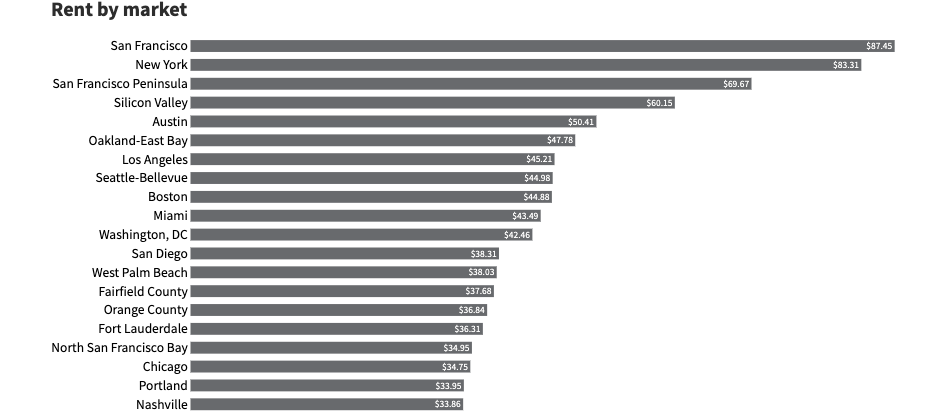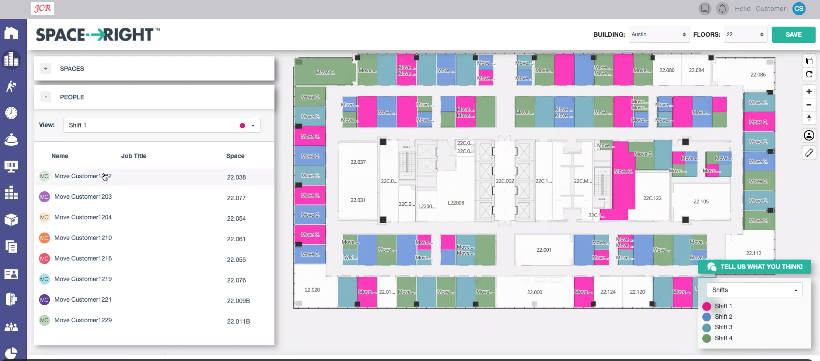How To Improve Desk Occupancy In Your Workplace


Desk occupancy has become a moving target these days.
If you’ve reopened your workplace, you probably have a significant percentage of desks sitting empty as more employees continue to work remotely.
And if your desks are close together, some may be temporarily blocked off to help you adhere to guidelines for physical distancing.
So, does desk occupancy even matter anymore? And assuming it does, what can you do to better align yours with the new realities of the workplace today?
Yes, desk occupancy still matters
The cost of office space hasn’t gone down just because we’re in the midst of a global pandemic. In fact, although leasing activity has dropped significantly and vacancy rates are upwards of 20% in some markets, rental prices have held steady.
JLL’s Q3 Office Outlook shows rent in the top 20 markets ranging from $33.86 per square foot in Nashville to $87.45 in San Francisco.

While real estate is typically your second-highest cost after employees, there are other costs associated with each desk or workspace.
JLL’s 3-30-300 rule is a good way to estimate your costs per square footage on maintenance and utilities ($3) in relation to your real estate ($30) and employee costs ($300).
This makes the average annualized cost of a single desk much higher. Workplace consultant Abintra estimates it’s as high as $18,000.
That number hits even harder if only 25% of your desks are occupied.
Desk utilization is an important factor in your real estate costs, but it’s also part of your workplace experience. Not everyone works well from home.
Recent research found only 12% of employees want to continue working remotely full-time, while the majority prefer to come into the office a few days a week.
Though the amount of time employees spend in an office has no real bearing on how productive they are, healthy desk occupancy levels indicate a workforce that is engaged and collaborative. When the office is no longer a place employees need to be, it can become a destination where they choose to go.
How to improve desk occupancy
Although desk occupancy rates shouldn’t be your primary barometer for success — especially in the midst of a global pandemic — they’re still an important metric.
What’s considered a good desk occupancy rate in the current market, however, is open to debate. There are many factors to consider and few benchmarks that exist for this new era.
Some organizations aren’t planning to reopen the office until next year. Others have reopened with new strategies that include options for remote work and fewer assigned seats.
These recommendations can help you get more use out of each desk.
Be mindful of safety considerations
Your workforce won’t be eager to return to the office if they don’t feel comfortable there.
And they won’t feel comfortable or safe if they’re sitting shoulder-to-shoulder with their colleagues or sharing desks that haven’t been properly sanitized.
Your return to work plans should start with reconfiguring your existing spaces to allow a greater distance between desks.
You will also want to consider how to screen employees and visitors for symptoms of illness, limit capacity in the office, and update your cleaning and sanitization protocols.
See how our solutions help you reopen safely.
Adopt flexible seating arrangements
More than half of real estate leaders were already phasing in some level of unassigned seating before the pandemic, according to research from CBRE.
Now, as they face even more uncertain office occupancy levels, many are adopting flexible space strategies like hot desking, office hoteling, or activity-based working.
While hot desking is a popular strategy, its informal nature makes many employees uneasy. Employees want to know they have space waiting for them when they arrive, even if it isn’t a permanently assigned desk.
They also want to know that space is clean, especially if it was recently used by someone else.
It’s not surprising, then, that Gensler’s research found 19% of employees wanted to eliminate hot desking altogether.
Use a desk reservation system
Desk booking software gives employees the freedom to choose a desk anywhere in your workplace, whenever they need it.
They can find and reserve a place to work ahead of time or when they arrive for the day. Ideally, they should be able to do this from a mobile app for a touchless experience.
Meanwhile, you can see real-time and historical desk utilization data.
You can see what percentage of desks are reserved at any point in time or over the course of a week or month.
You can see the average length of time for each reservation and which days and times were busiest. Knowing this information helps you make adjustments quickly and plan for the future.
Assign employees to alternating shifts
If you want to maintain assigned seats while improving desk utilization, you can try alternating shifts. For instance, you could have one group of employees come to the office on Mondays and Wednesdays, while the other group uses their desks on Tuesdays and Thursdays.
You could also manage multiple shifts in a single day with staggered arrival times.
Our Space-Right™ planning feature makes this easy.

Use occupancy sensors
Sensors add another level of accuracy to your desk occupancy data. You can use them with a desk reservation system or on their own.
Once you have sensors, you’ll have full visibility into desk occupancy and utilization over time.
You can see how often each desk is occupied during a typical work week and determine whether you need to make more assigned desks reservable or add new ones.
Sensors give you a daily view of office utilization so you can adjust your cleaning schedule accordingly.
See how iOFFICE integrates with sensors for intelligent cleaning.
They also allow you to establish your own benchmarks for success. You can get a baseline average of desk occupancy over a 30-day period and then continue to monitor trends.
If you notice a significant drop or uptick in the number of occupied desks for an extended period of time, it’s something you should consider as you plan your real estate strategy.
The future of office space is flexible
Occupancy is still an important metric for facility managers and workplace leaders, but the conversation around it is more nuanced today.
An office that was filled to capacity used to be a measure of success. Now, it’s become a matter of concern.
Even after the worst of the pandemic is behind us, it may not be realistic to expect employees to sit at the same desk five days a week. The reality is that they’ve become accustomed to greater flexibility, including the option to choose when they come to the office and where they sit.
While it’s still essential to have accurate data on office space utilization, understanding how your workforce uses your space is far more valuable today.
